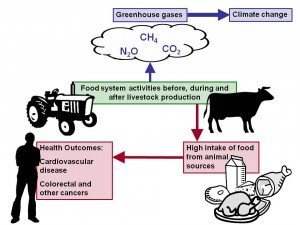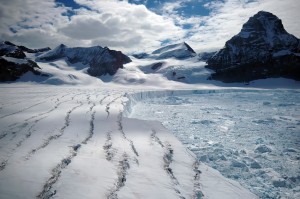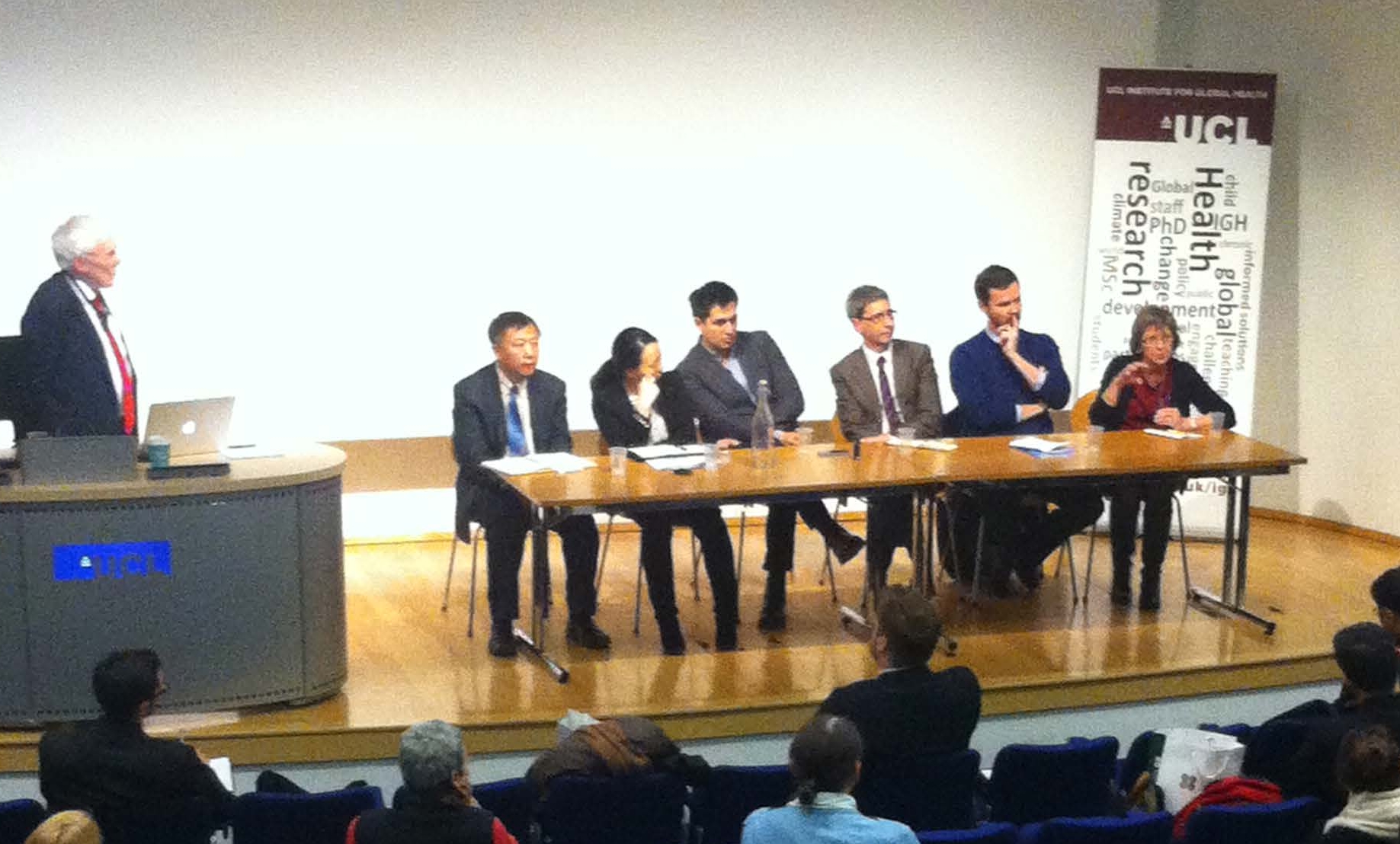The global health benefits of tackling climate change
The Climate and Environment at Imperial blog has moved. View this post on our new blog
by Professor Paolo Vineis and Pauline Scheelbeek, School of Public Health

It is sometimes claimed that addressing climate change with proper policies is too expensive and could lead to a further decline in the economy. However, the co-benefits of implementation of climate change mitigation strategies for the health sector are usually overlooked. The synergy between policies for climate change mitigation in sectors such as energy use (e.g. for heating), agriculture, food production and transportation may have overall benefits that are much greater than the sum of single interventions (Haines et al, 2009). Here we describe a few examples of climate change mitigation strategies that have important co-benefits for global health.
-
Reducing CO2 admission by promotion of active transport
The transportation sector is often the single largest source of greenhouse gas emissions in urban areas. Policy makers have tried to reduce these emissions by discouraging car travel and promoting other means of (active) transport. Active transport, such as cycling and walking, increases daily physical activity. Physical inactivity is one of the leading causes of non-communicable diseases all over the world. It has been estimated that the combination of active travel and lower-emission motor vehicles would give large health benefits, notably from a reduction in the number of years of life lost from coronary heart disease (10-19% in London, 11-25% in Delhi according to Woodcock et al, 2009). Also obesity, which is increasing dramatically all over the world, particularly in children, could effectively be reduced by a more active lifestyle. A 30-minute walk per day could – on many occasions – be enough to even out slight caloric excess.
-
Domestic energy management & reduction of cooking/heating emissions
Improving heating and cooking systems – for example by making them more efficient – reduces energy consumption. Improved models of stoves (electrical vs biomass) allow a 15-times reduction in the emission of particles and other pollutants, thus contributing to decreased emissions in the atmosphere. Especially in developing countries – where old stoves are common – these improvements could also have a considerable positive impact on health: cooking on simple wood or coal stoves currently forms a major source of indoor pollution and increases risk of certain chronic diseases, such as chronic obstructive pulmonary disease (COPD). The potential effectiveness of this strategy was shown by Wilkinson et al: they calculated that if 150 million low-emission cookstoves were introduced in India, this could lead to the prevention of an estimated 1.3 million deaths from COPD and hundreds of thousands of deaths from other diseases such as coronary heart disease (Wilkinson, et al 2009). Air pollution is one of the biggest environmental causes of death worldwide, with household air pollution accounting for about 3·5-4 million deaths every year (Gordon et al, 2014).
-
Reductions in CO2 through reduced meat production
 Meat production is highly inefficient energetically: it requires an extremely high use of water and land per unit of meat. One fifth of all greenhouse gases worldwide are related to methane production from livestock farms. Reduction of meat intake by consumers would lower meat production and is therefore often promoted as climate change mitigation strategy. The figure shows that a high intake of meat is also associated with increased disease risk, in particular for certain cancers and cardiovascular disease (WCRF, 2007). Reduced meat consumption would therefore also have a major impact on public health. It has been estimated that a 30% reduction in livestock production in the UK would reduce cardiovascular deaths by 15% (Friel et al, 2009).
Meat production is highly inefficient energetically: it requires an extremely high use of water and land per unit of meat. One fifth of all greenhouse gases worldwide are related to methane production from livestock farms. Reduction of meat intake by consumers would lower meat production and is therefore often promoted as climate change mitigation strategy. The figure shows that a high intake of meat is also associated with increased disease risk, in particular for certain cancers and cardiovascular disease (WCRF, 2007). Reduced meat consumption would therefore also have a major impact on public health. It has been estimated that a 30% reduction in livestock production in the UK would reduce cardiovascular deaths by 15% (Friel et al, 2009).
-
Low carbon energy production
Non-renewable energy production, for example coal burning, is a major contributor to worldwide greenhouse gas emissions. Many countries have adopted policies to reduce polluting energy production and stimulate production of (renewable) energy through cleaner sources. For example, since 2000, the government in the Chinese Shanxi province has promoted several initiatives (including factory shutdowns) with the goal of reducing coal burning emissions. The annual average particulate matter (PM10) concentrations decreased from 196 μg/m3 in 2001 to 89 μg/m3 in 2010, which – as a matter of fact – is still very high for Western standards. It has been estimated that the DALYs (Disability-Adjusted Life Years) lost in Shanxi had decreased by 56.92% as a consequence of the measures (Tang et al, 2014). The IPCC 5th assessment report stresses that the main health co-benefits from climate change mitigation policies come from substituting polluting sources of energy for renewable and cleaner sources, with a considerable effect on the improvement of air quality.
Practical conclusions
The co-benefits from climate change mitigation for the health sector have not yet been completely identified and quantified. The topic does not appear on the priority list of political discourse: relevant sectors, including those involved in non-communicable disease prevention (Pearce et al, 2014), transportation, agriculture, food production and climate change (Alleyne et al, 2013), still work separately, while collaboration would improve the synergy between health improvement and climate change mitigation and maximise benefits for both.
References
Alleyne G, Binagwaho A, Haines A, Jahan S, Nugent R, Rojhani A, Stuckler D; Lancet NCD Action Group. Embedding non-communicable diseases in the post-2015 development agenda. Lancet. 2013 Feb 16;381(9866):566-74. doi: 10.1016/S0140-6736(12)61806-6
Friel S, Dangour AD, Garnett T, Lock K, Chalabi Z, Roberts I, Butler A, Butler CD, Waage J, McMichael AJ, Haines A. Public health benefits of strategies to reduce greenhouse-gas emissions: food and agriculture. Lancet 2009; 374: 2016-25.
Gordon SB, Bruce NG, Grigg J, Hibberd PL, Kurmi OP, Lam KB, Mortimer K, Asante KP, Balakrishnan K, Balmes J, Bar-Zeev N, Bates MN, Breysse PN, Buist S, Chen Z, Havens D, Jack D, Jindal S, Kan H, Mehta S, Moschovis P, Naeher L, Patel A, Perez-Padilla R, Pope D, Rylance J, Semple S, Martin WJ 2nd. Respiratory risks from household air pollution in low and middle income countries. Lancet Respir Med. 2014 Oct;2(10):823-60. doi: 10.1016/S2213-2600(14)70168-7
Haines A, McMichael AJ, Smith KR, Roberts I, Woodcock J, Markandya A, Armstrong BG, Campbell-Lendrum D, Dangour AD, Davies M, Bruce N, Tonne C, Barrett M, Wilkinson P. Public health benefits of strategies to reduce greenhouse-gas emissions: overview and implications for policy makers. Lancet. 2009 Dec 19;374(9707):2104-14. doi: 10.1016/S0140-6736(09)61759-1. Epub 2009 Nov 26.
Pearce N, Ebrahim S, McKee M, Lamptey P, Barreto ML, Matheson D, Walls H, Foliaki S, Miranda J, Chimeddamba O, Marcos LG, Haines A, Vineis P. The road to 25×25: how can the five-target strategy reach its goal? Lancet Glob Health. 2014 Mar;2(3):e126-8. doi: 10.1016/S2214-109X(14)70015-4.
Tang D, Wang C, Nie J, Chen R, Niu Q, Kan H, Chen B, Perera F; Taiyuan CDC. Health benefits of improving air quality in Taiyuan, China. Environ Int. 2014 Dec;73:235-42. doi: 10.1016/j.envint.2014.07.016. Epub 2014 Aug 27.
Wilkinson P, Smith KR, Davies M, Adair H, Armstrong BG, Barrett M, Bruce N, Haines A, Hamilton I, Oreszczyn T, Ridley I, Tonne C and Chalabi Z. Public health benefits of strategies to reduce greenhouse-gas emissions: household energy. 2009. The Lancet, 374: 9705 (P1917 – 29)
World Cancer Research Fund. Recommendations Booklet. Available from: http://www.wcrf.org/
Woodcock J, Edwards P, Tonne C, Armstrong BG, Ashiru O, Banister D, Beevers S, Chalabi Z, Chowdhury Z, Cohen A, Franco OH, Haines A, Hickman R, Lindsay G, Mittal I, Mohan D, Tiwari G, Woodward A, Roberts I. Public health benefits of strategies to reduce greenhouse-gas emissions: urban land transport. Lancet. 2009 Dec 5;374(9705):1930-43. doi: 10.1016/S0140-6736(09)61714-1. Epub 2009 Nov 26.



